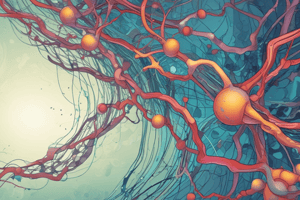Podcast
Questions and Answers
Which class of microtubule-based positioning mechanisms involves the organelle sliding along the microtubule?
Which class of microtubule-based positioning mechanisms involves the organelle sliding along the microtubule?
- None of the above
- Both classes
- Class 2 (correct)
- Class 1
What generates a pushing force in microtubule-based movements?
What generates a pushing force in microtubule-based movements?
- Microtubule polymerization (correct)
- Motor proteins
- Microtubule depolymerization
- All of the above
What is the function of microtubule pushing mechanisms?
What is the function of microtubule pushing mechanisms?
- None of the above
- To move organelles over large distances
- To interact with the cell cortex
- To center organelles in symmetric geometries (correct)
Study Notes
Microtubule-based positioning mechanisms in cells
- Microtubules are crucial for the dynamic organization of the cell interior and are key organizers of the cell interior.
- Microtubules are dynamic polymers that can interact temporarily with cellular components, search the intracellular space, disassemble, assemble, and dynamically position cell organelles.
- Microtubule-based positioning mechanisms can be divided into two classes: Class 1 where the organelle is firmly bound to and moves together with the microtubule and Class 2 where the organelle slides along the microtubule.
- Class 1 movements can be further divided according to the site of force generation, which is either at the microtubule end or along the lateral sides of the microtubule.
- With respect to the force direction, the movements can be driven either by pushing or pulling.
- A pushing force generated by the microtubule end is typically based on microtubule polymerization, whereas a pulling force is generated by motor proteins and/or microtubule depolymerization.
- Microtubule sliding is powered by motor proteins and can be regarded as either pushing or pulling, depending on the direction of motor motion.
- Organelles can be bound to a set of overlapping microtubules that pull them together or push them apart, according to the motor activity in the overlap zone.
- Microtubule pushing mechanisms are efficient for movements over small distances and for centering of organelles in symmetric geometries.
- Mechanisms based on pulling are typically more elaborate but are necessary when the distances to be covered by the organelles are large and when the geometry is asymmetric and complex.
- The mitotic spindle is a complex microtubule-based positioning mechanism that segregates sister chromatids during cell division.
- Spindle elongation, i.e., the movement of the spindle poles, plus the attached chromosomes, away from each other can be accomplished by two mechanisms: (1) the overlap microtubules of the central spindle interact via molecular motors which slide them apart; (2) astral microtubules interact with the cell cortex via molecular motors, which pull the spindle poles apart.
Studying That Suits You
Use AI to generate personalized quizzes and flashcards to suit your learning preferences.
Description
Test your knowledge on the fascinating world of microtubule-based positioning mechanisms in cells! This quiz will cover the dynamic organization of the cell interior, the two classes of microtubule-based movements, and the different types of forces involved in these movements. You'll also learn about the complex mitotic spindle and how it segregates sister chromatids during cell division. Keywords include microtubules, organelles, motor proteins, polymerization, and depolymerization. Challenge yourself and



